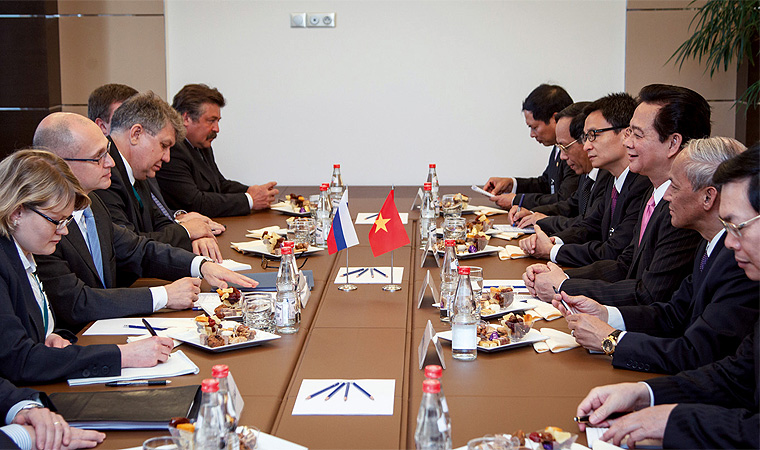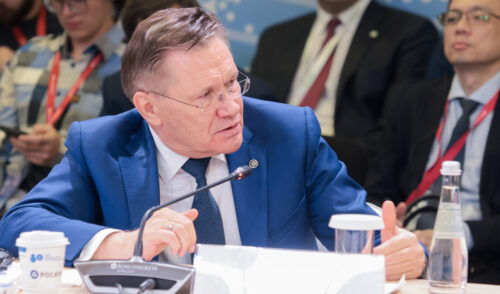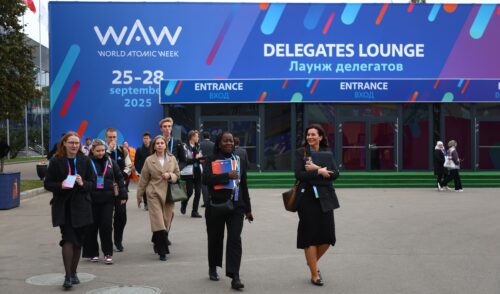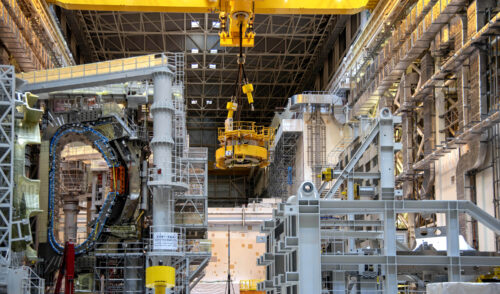
Complex For Export
back to contentsThe key element of the Rosatom’s complex offer today is design and construction of NPP based on safe and efficient VVER technology. Today the State Corporation is building 19 power units in 15 countries. Russian company shows some fruitful cooperation with the neighbor countries, such as the construction of the Ostrovets NPP in Belarus, which is going ahead of schedule. This year the pit earthwork for unit 2 has started on the site. The work is going on at two units simultaneously.
According to Yury Pustovoy, the Belarus NPP Director for Construction, the work on all 62 objects of production base and off-site objects of network and building, providing the work of production base will be fully completed by September 2013. The Belarus NPP will consist of two units with total capacity up to 2,4 MW, it will be built on the Ostrovets site, Grodno region. The first unit is planned to be launched in 2018. It has the “AES-2006” project as its base.
Atom for Asia
Rosatom’s offer is in demand at Asian market. The main event of the recent months has become the agreement between Russia and Bangladesh. As we remember, in November 2011 the sides signed an intergovernmental agreement concerning construction of the first Bangladeshi NPP (two Russian-designed power units 1000 MW each). During the official visit of Sheikh Hasina Wazed several agreements on the project were achieved. After the negotiations in Moscow Russia was announced to open a $500 million credit for the initial stage of the NPP construction. The work on site starts as early as January 1 of the next year, the main construction stage – in the beginning of 2015.
Rosatom is building the first power unit in Vietnam. The State Corporation General Director recently discussed construction details with the Vietnam Prime Minister. The meeting between Sergey Kiriyenko and Nguyen Tan Dung took place during the official visit of the Vietnamese PM to Russia. The Head of Government thanked the Russian side for the credit spared and for the help in the Nin Thuan-1 project realization. “Rosatom has authority not only in Russia but in the whole world. Nin Thuan NPP will play an important part in our country’s energy security provision” – said Nguyen Tan Dung.
The Head of Rosatom, on his part, assured the PM that the State Corporation “will do its best to build the most safe and modern NPP”. “We see the task to build a NPP in Vietnam as a high trust”, – emphasized Kiriyenko. Nguyen Tan Dung also spoke to the Russian PM Dmitry Medvedev. “We agreed to have a strong cooperation in the Vietnamese NPP construction, so that the project could develop according to the schedule with the use of the most advanced technology” – said the PM of Vietnam. Medvedev, in his turn, expressed hope that the cooperation with Vietnam would go beyond the limits of the NPP construction help, “allowing us to form the infrastructure”.
On the New Year Eve in the Lianyungang city a historical event took place – first concreting of the unit 3 bedding of the Tianwan NPP, being built by Rosatom upon the agreement with China on the coast of the Yellow Sea. The first two units were also built by Russian specialists. The unit meets international norms of nuclear and radiation safety. The reactor building is covered with double containment: inner enclosure vessel excludes radiation leakage, the outer containment is meant for protection of the reactor from external factors. Below the reactor vessel there is a melt trap for the molten reactor core catching and cooling. It is meant for the case of emergency, so that molten core could fill the core melt trap, not destroying the base below the reactor vessel and building. The core melt trap has an original technical design, with no analogs in the world NPP construction practice. China has become the first country using the layout. The core melt trap project, designed by Russian scientists, successfully passed Russian and Chinese regulatory agencies’ expertize and was approved by the IAEA. The station has a four-channel safety system structure, the combination of active and passive protection systems is used, a digital control system is applied. With the pace of work taken by Rosatom new units won’t take long to follow. A preliminary agreement on negotiations concerning joint construction of the fifth-eighth units of the Tianwan NPP has already been achieved.
Russian specialists are ready to launch the Kudankulam NPP in India. The construction of the biggest NPP in the world has come to its final stage. Rosatom fully fulfills its obligations concerning the construction, the only thing that can be a problem is political issues in India. The Kudankulam project is designed on the basis of serial units with B-320 reactor vessel, being long used in Russia and Eastern Europe; the “AES-92” project, certified by EUR, is also implied. The project’s special feature is a unique combination of active and passive safety systems, adaptation for tropical climate. The project is of the third generation of modernized water reactors and meets international requirements for atomic stations, put into operation after the year 2000.
Build-Own-Operate
These days Rosatom is able to imply foreign projects on the build–own–operate basis. The first project of this type was Turkish Akkuyu. This construction is also particularly important, since it proved competitive ability of the VVER- TOI project at the world market. VVER-TOI is the project chosen by Turkey for its plant. The choice was made after Fukushima, when the fear of peaceful atom was at its peak. VVER- TOI is a standard optimized computerized project. The capacity of one power unit is 1255 MW with a pile assembly of a B-510 type. The project combines active and passive safety systems, providing functional redundancy. Additional measures for long-lasting self-support of the unit during accidents within and off-design basis. Passive systems go off when something refuses to perform its function. Active safety system gives personnel the opportunity to take measures, bring additional equipment, connect to alternative energy sources etc.
This project is of a higher safety level than others, even not taking into consideration the core melt trap, which has already become somewhat obligatory. Hands-free station management resource is altered up to 72 hours. It’s a lot, since usually just one hour is enough for personnel to handle the situation. The Akkuyu NPP is planned to consist of four units with total power no less than 4800 MW.
European Prospects
No matter how enormous is the scope of foreign orders, Rosatom still retains interest in joining more foreign NPP construction projects, said not so long ago Rosatom’s General Director Sergey Kirienko to journalists. “We are still interested in monitoring all projects in progress. Today we work in Europe a lot, however we are keeping an eye on even more projects than we are about to take part in”.
One of the most important tenders for Rosatom is Temelin units’ construction in the Czech Republic. Russian Corporation is taking part in it as a part of Russian-Czech consortium MIR.1200. MIR.1200 is a 1200 MW Modernized International Reactor. The base is the “AES-2006” project designed in Saint-Petersburg (SPbAEP). Alexander Kazarin, SPbAEP Design Director, calls this project more evolutional than other AES projects of VVER reactors of advanced security, since it is based on referential engineering solutions. The project is meant for implementation in Europe and, in particular, takes into consideration some tender specifications for the Temelin NPP further construction. This project is unique, combining modern active safety systems and passive control systems meant for accidents beyond the design basis and fully meets the IAEA and EUR requirements in safety. The MIR.1200’s rival for units’ 3 and 4 is Westinghouse, American-Japanese company. The cost of the contract is $15 billion. The second stage is planned to start in 2016, while the launch is estimated for no later than 2025.
Russian offer concerning the Czech NPP further construction is leading in most points. The winner will be chosen upon final results. Leos Tomichek, Executive Vice-President of Rusatom Overseas (Rosatom’s promoter abroad) said the results are expected in September-October.
Sergey Boyarkin, the Executive VP’s Counselor, said in his turn, that if MIR.1200 wins the tender, there will be 9 thousand new working places created in the Czech Republic, which is very profitable for the host. “75% of equipment for the project would be produced at local enterprises, – Boyarkin gives his prognosis. – Besides Czech engineers and regulatory authorities know very well our technologies and can use them on their own, while those of the USA, for instance, the Czech side wouldn’t be able to use without American representatives”.
Besides, not a long time ago it was announced that Rosatom had been invited to build NPP in Finland. Fennovoima company offered Russia to start direct negotiations concerning reactor supply for the Hanhikivi-1 NPP. The Finns chose the 1200 MW pressurized water reactor, used in Russian “AES-2006” project. Possible tender rivals – Japanese Toshiba and French Areva (possibly joint with Mitsubishi). The supplier is planned to be chosen by Fennovoima in the course of this year. The construction will start in 2015, launching is planned for 2020. The total cost of construction is EUR 4-6 billion.
Rosatom also considers possibility of building the newest NPPs in Great Britain. It also offers its British colleagues services in the sphere of regulating. “As early as this year Rosatom has started reactor licensing in Great Britain, said Jukka Laaksonen, Rusatom Overseas Vice President in his interview to the Pravo newspaper.
In Layman’s Terms
After Fukushima the significance of public acceptance-related activities has grown a lot. Rosatom opens nuclear information centers in the countries where NPPs with the participation of Russian specialists are constructed. Anyone is welcome. An information center is a modern multimedia film-theater, combining panoramic 3D-projection, computer graphics and animation, stereo-sound, interactive panels and personal monitors. The technology gives a full virtual reality immersion experience.
The base product of the center is a 45 minute activity presented as a virtual performance called “The World of Nuclear Power”. The program is meant for laymen, includes several interactive modules with quizzes. Prize-winning at the end makes the whole thing more entertaining. There are also small booklets, educational literature and souvenirs available. Today those kinds of centers are already open in Hanoi (Vietnam), Mersin (Turkey), Dhaka (Bangladesh). The centers are soon planned to be open in Prague (Czech Republic) and Minsk (Belarus).




